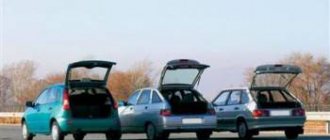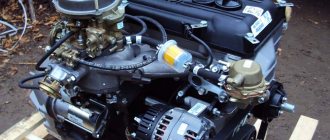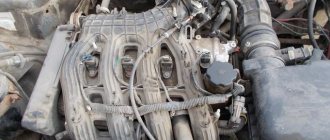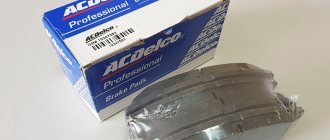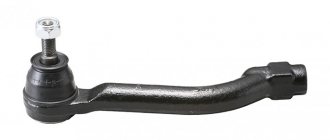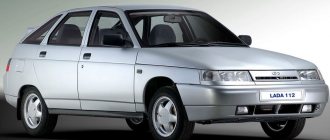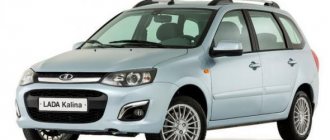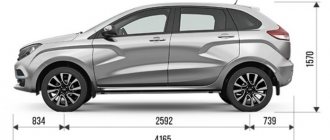Choosing a used "ten"
The “tenth” family from Tolyatti - the Lada 110 sedan, the Lada 111 station wagon and the Lada 112 hatchback, also known under the indices VAZ-2110, 2111 and 2112 - are no less significant in the history of AvtoVAZ, and indeed the entire domestic automobile industry, models than the classic " Zhiguli" and promising at the time of the appearance of "Samara".
The Ten, originally developed as a sedan based on the Eight, received many changes and improvements that made the car more expensive, and generally separated this project from the Samar. The Lada 110 was positioned as a higher-class model, modern and competitive, which, by the way, was more expensive than such foreign cars as, for example, the Skoda Felicia.
“Ten” attracted buyers, including an electronic engine control system, an on-board computer, body parts made of galvanized metal, the ability to install electric windows and power steering. The design and variety of tuning options for models with three- and five-door hatchback bodies attracted young people.
Families, and especially those with dachas, willingly chose Lada 111 station wagons for their decent-sized luggage compartment.
And, of course, like other Lada models, the “tenth” family was valued for its inexpensive, easily accessible spare parts, low maintenance costs, and also for its efficiency.
However, the “ten”, “eleventh” and “twelfth” can boast of these and many other qualities to this day. Therefore, the Internet is full of advertisements for the sale of such used cars in different versions and variants.
Having been conceived as a “eight” with a sedan body, but not becoming one, the VAZ-2110 model came out later than the “ninety-ninth”.
The first prototype of the “ten” appeared back in July 1985, and 5 years later the pre-production car was already tested at the Porsche test site in Germany. Due to the crisis in the country, the launch of the “ten” into production shifted from 1992 to 1995.
The first commercial vehicles were assembled on June 27, 1995 at the AvtoVAZ pilot production facility, and mass production on the car plant’s assembly line was launched in 1996.
A front-wheel drive station wagon based on the "Ten" under the designation VAZ-2111/Lada 111, produced since 1998. And the 5-door hatchback VAZ-2112/Lada 112 was released in 1999.
The latter had a shorter body compared to the sedan (up to 4170 mm) and therefore better handling.
And the rear seat from the station wagon, folded in parts, increased the volume of the 350-liter trunk at the expense of space in the cabin to 720 liters.
In 2002, the subsidiaries began producing the three-door Lada 112 Coupe based on the hatchback. Since 2006, it has already been assembled in the pilot industrial production of the Tolyatti auto giant.
After the launch of the new Lada Priora into production in March 2007, which was the result of a deep restyling of the “ten”, the latter lost popularity and was removed from the AvtoVAZ assembly line on October 15 of the same year.
The five-door car was discontinued in Tolyatti in 2008, and in 2009 the Lada 111 station wagon and three-door hatchback became history. But the production of the sedan and station wagon did not stop completely.
Until 2014, these two models were assembled from AvtoVAZ vehicle kits under license under the Bogdan brand at the automobile plant of the corporation of the same name in the Ukrainian city of Cherkassy.
Having analyzed most of the advertisements for the sale of used models of the “tenth” Lada family published on the Internet, we found out which of them are best represented on the second-hand market and with which engines. As expected, the most popular of the trio was and remains to this day the Lada 110 sedan.
It accounts for 51% of offers for sale. The second is the five-door Lada 112 – 35% . There are almost three times fewer summer residents and family drivers who wanted to part with their Lada 111 station wagon – 12% .
Three-door hatchbacks accounted for only about 2% of ads.
There is no need to talk about various versions and modifications with stretched bodies such as the Lada Premier, the Consul limousine, the all-wheel drive Tarzan or the two-door Lada 1106 Coupe. They were produced in small quantities and are extremely rarely found on sale.
As for the engines, of which the “tenth” family had plenty in various versions and modifications with different power, the ones most often found in offers on the secondary market are in-line atmospheric 8- and 16-valve gasoline 1.5 and 1.6, developing from 78 to 93 “horses”.
Cars with the former are represented in the majority - 56% , but there are not much fewer options with the latter - 43% . For all others, including the 105-horsepower 1.8 version on hatchbacks and the 150-horsepower Opel 2.
0 on sedans and station wagons, accounting for about 1% of ads.
Unfortunately, the manufacture of a number of body parts from steel sheets with zinc-metal coating (front mudguards, front fenders, hood, outer door panels, trunk lid panel, floor cross members and outer rear wheel arches) did not save the cars of the “tenth” family from corrosion. Chips of paint that are not of the best quality, if they are not immediately painted over after they appear, will eventually turn into pockets of the “red plague.” Typically, rust on a 10's body can be found on the leading edge of the roof along the windshield seal, as well as on the hood.
If after purchase and during operation the previous owners did not additionally treat the car with anti-corrosion compounds and did not install plastic wheel arches, then rust may be found on the wheel arches. In addition, it may appear at the bottom of the doors due to clogged drainage.
On Lada 111 station wagons, as a rule, the roof rails peel off, and on all cars in the family, the lower part of the front bumper is often damaged. It doesn’t affect the speed, but it’s fine as an argument for bargaining.
And of course, buying a car that has been in an accident and subsequently repaired poorly poses a certain risk.
It can be identified, in particular, by differences in the color shade of the panels, if the body was not painted entirely, as well as by traces of removing the wings and hood - stripped bolts of their fastenings.
And also by deformations of the metal of the trunk floor and power elements of the body, partially visible in the engine compartment.
About engines
The most common engines found under the hood of models of the “tenth” family are in-line naturally aspirated 8- and 16-valve “fours” with a volume of 1.5 and 1.6 liters, as well as their various modifications.
In general, 8-valve engines are characterized as simpler and more unpretentious, while 16-valve engines are characterized as dynamic and better suited for fast driving. According to reviews from owners, both are quite reliable. With timely care and maintenance, they can last up to 200,000 and even up to 300,000 km.
The exception is cars manufactured in 2002-2003 - defects and defects are not uncommon.
Both engine options are with a timing belt drive. And if with a 1.5-liter 8-valve engine and both versions of a 1.6-liter engine, its breakage does not lead to damage to the valves, then with a 16-valve 1.5 engine this sometimes happens.
Therefore, the manufacturer recommends that on such an engine, every 30,000 km, check the condition of the belt, which costs 600 rubles, and also change it more often - once every 45,000 km, and not every 75,000 km, as with other “tens” engines. In general, 16-valve engines of this model require good service and oil.
If you save on the latter, then once every 100,000 km you can “get” to replace the hydraulic valve clearance compensators - from 300 rubles for each.
At the same frequency, clearances require adjustment on 1.5-liter engines, and replacement of piston rings, costing from 1,000 rubles per set, may be necessary approximately once every 120,000 km.
Also among the weak points of the engines are the mass air flow sensor (MAF) and the idle air regulator (IAC) costing from 2200 and 850 rubles, respectively. They fail due to contamination. The need to replace them will be indicated by high and unstable idle speeds - up to 1200 - 2000 rpm.
And a malfunction of the first will result in increased fuel consumption of the car. By the way, sometimes the air flow sensor can be brought back to life by washing it with carburetor cleaner.
About the transmission
Lada 110, 111 and 112 are equipped with a non-alternative 5-speed manual transmission. Among its disadvantages, in addition to noise, the owners of these models most often cite a problem with engaging individual gears - especially the second.
The culprit is a failing synchronizer costing about 1000 rubles, which operates under heavy loads when switching from 1st to 2nd stage.
At first - on cars produced before 2003 - there were complaints about gearboxes due to a fragile secondary shaft costing 1,560 rubles, and cracking brackets for the gear selection mechanism. But on later cars there were no such complaints.
Minor problems with the transmission can also include wearable “penny” plastic bushings. If the speedometer needle twitches while driving on the car being inspected, then the speed sensor for 540 rubles may have failed.
The clutch assembly of the “tenth” family, costing 3,100 rubles, wears out depending on the driving style of the car owner and, together with the cable, can easily last 100,000 km or more.
By the way, whether the gears change easily in the box also depends on the oil, which is recommended to be changed every 30,000 km.
Rest
When choosing used Lada 110, 111 and 112, pay attention to how the car brakes.
If at the same time you feel a strong vibration, as if the car is driving on a washboard, then most likely the brake piston is jammed, and also, possibly, the handbrake.
The “tenth” family suffers from souring and leakage of the rear brake mechanisms. But if the previous owner of the car changed the cylinders and drums to better analogues, then you will not encounter such a problem.
The weak points in the suspension of the “tens” and its related models are often shock absorbers, which cost at least 2,000 rubles for the front ones and 1,450 rubles for the rear ones.
They can run smoothly for 150,000 km, but they can fail after 20,000 – 40,000 km. Ball joints last an average of at least 40,000 km and cost 740 rubles.
Wheel bearings from 370 rubles last a little longer, and CV joints from 1300 rubles external and from 1600 rubles internal may require replacement every 50,000-60,000 km.
And the “ten” also has a lot of problems with electrics: from brake lights and headlights not lighting up due to poor contact on cars of early years of production, to failed electric windows costing 1,400 rubles each, and door lock drives costing 600 rubles.
Therefore, when inspecting the car you like, check the operation of all electrical appliances, press all the buttons and levers in the cabin, and also make sure that they turn on and off what they should.
Few people would want to disassemble the door trim in order to raise the glass in it if its electric drive suddenly gives up its life.
How much?
The range of prices for sedans and station wagons of the “tenth” AvtoVAZ family is approximately the same - from 40,000 rubles for cars that require cleaning up to 190,000 rubles for copies of the last years of production in Togliatti.
For cars under the Bogdan brand, which were assembled in Ukraine under license until 2014, they ask from 190,000 to 220,000 rubles. Lada 112 hatchbacks, now offered on the secondary market, are often better preserved compared to sedans due to their greater popularity among young people.
But they are already asking for them from 45,000 to 250,000 rubles.
Our choice
According to Am.ru, of the entire “tenth” family with mileage, it is advisable to consider only station wagons from the last years of production as candidates for purchase.
Most often, these are well-groomed family cars that have not been used in taxis, have not been lowered or disfigured by minor customizers, and are also unlikely to have taken part in street racing or any tuning shows.
Moreover, quite good-looking copies are offered on the Internet at a price of about 140,000 – 150,000 rubles.
Source: https://auto.youla.ru/journal/7592/
Which VAZ models are preferable?
When choosing a used car, one of the main parameters is its cost. For used VAZ cars with a price tag of 40-50 thousand rubles. It's better not to pay attention at all. For that kind of money, in most cases, sellers offer a pile of scrap metal, which will require considerable financial investment and frequent repairs. Next, let's look at more expensive options.
Budget 60-70 thousand rubles.
In this price category, it is optimal to choose representatives of the classics - VAZ 2105, VAZ 2106 or VAZ 2107. It is advisable to buy a car no older than 2003-2004. These are reliable and time-tested cars, which, with proper care and compliance with operating rules, will last for many more years.
Budget 80-90 thousand rubles.
Here the undoubted leader is the VAZ 21099, released 10-12 years ago. It is better to choose a vehicle with an injector. Experts do not recommend buying cars with a carburetor. If you decide to choose this model, pay special attention to checking the brake system. Make sure that there are no oil or other liquids leaking, and that there is no rust on the arches and sills. In addition, the weak point of the VAZ 21099 is the interior heater, so make sure it is working. Another problem inherent in these models is the strong rattling of interior trim parts, which, however, is observed in almost all old Zhiguli models.
Budget 120-160 thousand rubles.
In this category you can choose VAZ 2112, VAZ 2114 or Kalina. The latest model is one of the most successful creations of VAZ. Among the advantages of Kalina it is worth noting:
- good value for money;
- level of technological equipment not inferior to many manufacturers;
- high ground clearance, which ensures high cross-country ability;
- spacious interior;
- decent anti-corrosion properties of the body.
If you decide to choose a used VAZ 2112, first of all, check the engine. Extraneous noises from under the hood will indicate problems with the hydraulic compensators. In addition, ask the seller what type of fuel was used to refuel the vehicle: grade 92 gasoline does not have the best effect on the stability of the 16-valve power unit.
The VAZ 2114 is not very different in design from the 9 Series models, therefore it has the same problems as the VAZ 21099 (they were mentioned above).
Budget from 200 thousand rubles.
If you decide to choose a more expensive used car, pay attention to Priora or Granta. These models are distinguished by high safety indicators, increased interior comfort, and good noise insulation properties. Among the shortcomings, experts note the whimsical quality of fuel (it is advisable to fill the car with 95 grade gasoline), oil and other consumables.
For residents of rural areas, as well as city dwellers who are interested in outdoor activities, travel, hunting or fishing, experts recommend choosing the Lada Largus or Niva. The models are distinguished by high cross-country ability, a spacious interior and ease of use.
Whatever VAZ model you choose, before making a purchase, check the used car using the all-Russian Internet service “Autocode”. Enter state in the search field on our website. vehicle number or VIN. In a few minutes you will be able to view the detailed history of the vehicle. The report will contain information about the number of owners of a used car, the presence of encumbrances and restrictions on registration actions in the traffic police, information about fines, accidents and other useful data, based on which you will draw conclusions about the wisdom of purchasing a car.
If you are a professional car seller, use the “Autocode Pro” unlimited car check service. “Autocode Pro” allows you to quickly check a large number of cars, add comments to reports, create your own lists of liquid vehicles, quickly compare options and store data about cars in an orderly form.
Before concluding a purchase and sale agreement, we also recommend checking the owner of the car through a special service. The check will show whether the seller has problems with the law, whether his passport is valid, whether there are debts and enforcement proceedings. If serious problems are discovered, it is better to refuse the deal. View an example report
VAZ 2110 or VAZ 2112: comparison of cars and which is better
The domestic automobile industry occupies the largest share in Russia among all cars. They are so popular because of their significant qualities. They are almost completely adapted to our climatic conditions and roads. They also attract with their affordable price compared to foreign cars.
VAZ 2110
This car has been produced since 1995. At first they were with carburetor engines, but soon they began to be produced with injection engines . In addition to eight-valve ones, sixteen-valve engines with a larger volume also appeared. We finished producing this car in 2007. The design of the car is very nice.
Streamlined shapes will attract almost any motorist. This car is quite practical. The ground clearance is quite high and is not afraid of potholes and uneven roads. With such a car you can easily go outdoors or travel. Conveniently opening doors. Quite spacious and comfortable interior. Side and rear view mirrors provide a wide view.
Maximum visibility of what is happening outside the car. A large, capacious trunk will allow you to transport many loads without occupying the interior. The multimedia system is a standard radio.
The steering wheel does not have any power amplifiers, but rotates quite comfortably. A manual transmission will allow you to independently control acceleration and speed.
The headlights have a wide range and illuminate a fairly large road surface.
Advantages:
- High ground clearance.
- Easy to manage.
- Handles well on the road.
- Roomy.
- Good driving characteristics.
- Minimal expenses.
VAZ 2112
This model has been produced since 1999. It is considered the prototype of the VAZ 2110 , but more advanced and closer to a sports car. Released in a hatchback body.
But despite this, it has a fairly spacious trunk. Another advantage of this car is that the rear seats fold down, each separately.
Due to this, it is convenient to transport larger and longer luggage.
Quite a nice pendant. The car drives quite smoothly, “swallowing” potholes and bumps. The car is well suited for off-road travel and rough roads.
It adapts quite well to Russian climatic conditions. Available with eight- and sixteen-valve engines. Manual Transmission. Steering without power steering.
It has a fairly large ground clearance, which allows you to easily go around potholes.
General in VAZ 2110 and 2112
- The body is almost completely identical to the front part.
- Motor system.
- Interior decoration, multimedia.
- Steering system and gearbox.
- Many spare parts are interchangeable and fit both cars.
- Mirrors.
Distinctive features
The most important difference, of course, is the body . Hatchback and sedan. Everyone has their own fans. Some people fundamentally prefer the first option, while others prefer the second. Due to the body, the driving style of the car is also different. The VAZ 2112 is significantly shorter, which allows it to be more maneuverable and take turns better.
The next difference is the difference in clearance. It is not big, only 5 mm. This fact doesn’t make much of a difference. Both cars have a fairly high level of cross-country ability and are quite tall, which is well suited for bad roads. The bumpers are not mounted low and do not touch bumps.
Fuel consumption differs slightly . Literally a few tenths. Both cars are practical and inexpensive to maintain. The fuel tank volume is the same.
But the acceleration speed differs by as much as 3 seconds . This is not a small gap. The VAZ 2110 accelerates faster due to its weight and streamlined body.
This time is 14 seconds to 100 km . The VAZ 2112 is more massive and harder to accelerate, but it is more maneuverable and avoids obstacles well. Also different is the power.
Ten has seven more horses. This is the main reason why the acceleration time is lower.
Another major difference is the volume of the luggage compartment. Of course, in a hatchback it is much smaller, due to the properties of the body.
But despite this, there are distinctive advantages, and this is the ability to fold out the rear seats, thereby increasing the trunk volume. In turn, creating the discomfort of moving in the cabin.
Especially if this trip takes place in winter. The trunk is not insulated and the interior is instantly cooled.
It is also worth noting that the 2112 is more comfortable and functional than the 2110 . It has more options regarding interior properties. There is also a difference between the panels.
Of course, the VAZ 2112 is most likely not suitable for family trips and trips out of town to the dacha with a group. And this is due to its limitations in space and luggage space.
Such a car is preferably suitable for a young man or girl who does not travel in large groups and does not like long journeys. You can go fishing or nature in the 2112, it allows you to do this thanks to its cross-country ability, but without a lot of luggage.
On the contrary, the VAZ 2110 is suitable for families or for traveling in large groups. Departure to the dacha with various seedlings and equipment.
Source: https://vchemraznica.ru/vaz-2110-ili-vaz-2112-sravnenie-avtomobilej-i-chto-luchshe/
VAZ-2111
The previous modification of a similar body design – the legendary 2104 (“four”) – was already 15 years old by the time the production of 2111 began. VAZ-2111 is the first VAZ station wagon with front-wheel drive.
The trunk volume with a total vehicle load capacity of 500 kg varies from 490 to 1420 liters. This is due to the fact that the rear seats can be folded in such a way as to create a flat horizontal floor, and the backrest, if necessary, can easily be folded out in a ratio of 1:2. If there is a luggage structure, an additional 50 kg of cargo can be placed on the roof. Also, with a towbar, it is possible to tow a trailer up to 1000 kg, equipped with brakes. The car body is mounted on a supporting frame with rubber-metal elements, on which it rests at 10 points. Thanks to this solution, it was possible to reduce the level of vibration and noise in the cabin, and the body became stronger and more durable. The choice of engines for the 2111 is similar to the sedan. There is also a 21110 with an eight-valve 1500 cc engine. cm with a power of 76 l. With.; 21111 with a carburetor engine (from a VAZ-21083) with a volume of 1500 cubic meters. see and 21113 with a sixteen-valve engine with a capacity of 1600 cc. cm increased power.
There were also 3 configuration options - “standard”, “luxury” and “norm”. In 1997, together with the AVTOVAZ Research and Development Center, the DECON design group created a new comfortable SUV and called it “Tarzan”. The car is a hybrid of the body structure and frame chassis of the front-wheel drive models of the “tenth” family with transmission elements and main suspension components from the Niva (2121). Moreover, all units, except for the elongated cardan shafts and the frame itself, are serial.
The legendary “Ten” (VAZ 2110). Pros and cons of the car
The design of the VAZ 2110 began back in 1983. The very first car of this class was supposed to be a rear-wheel drive sedan. However, the development never reached its finish line.
Subsequently, the development of a car based on the VAZ 2108 began, but the price of such a car resulted in a fairly substantial amount, which forced the developers to freeze this project as well.
In the future, all these developments will result in the VAZ 21099 model.
The Togliatti AvtoVAZ plant planned the release of the first “ten”, in the form in which we see it, for 1992. But the time was not calm for Russia, and her birthday was moved to the summer of 1995.
And on June 27, the first, and so beloved by quite a large number of people, “ten” (VAZ 2110) rolled off the AvtoVAZ assembly line. This model was produced for 12 years, until 2007. After which LADA PRIORA came to replace it. Now this car is produced in the city.
Cherkassy in Ukraine, and is called Bogdan.
Features, modifications and characteristics of the VAZ 2110
The tenth AvtoVAZ family includes the following modifications. VAZ 2111, 2112, and of course the “ten” VAZ 2110 itself. The cars are equipped with four-cylinder, eight and sixteen valve gasoline engines. Volume from 1.5 to 1.6 liters.
Initially, the VAZ 2110 was produced with a carburetor power system, and after 2000 it began to be supplied with distributor fuel injection (injector), front-wheel drive.
Body types: VAZ 2110 (sedan), 2111 (station wagon), 2112 (hatchback). If we consider all the modifications from the point of view of repair, we will not find any significant differences. The only difference is different body types and engines. The remaining parts of the car are almost identical to each other.
Production of the VAZ 2110 in Russia was suspended back in 2007, but this development of AvtoVAZ, to this day and in large numbers, can be seen on the roads of our country. This trend has taken hold due to the sufficient reliability of the car, its design, and the low budget price of the car.
Of course, there is no need to talk about luxury inside the cabin. But compared to the VAZ 21099 model, there is much more space in the top ten, especially in the rear seats. Fuses and relays for the main functions of the car are located in the cabin, on the left side under the steering wheel, which is very convenient, unlike 21099.
VAZ 2110, comes with engines 2110, 2111, 2112. Engines 11 and 12 models are equipped with an injector, and models 10 are equipped with a carburetor. With a working engine and battery, it starts even in very severe frosts, down to -25 it will grab quite easily, even if it sits for a couple of days without moving.
It is advisable, of course, that the oil be filled according to the season.
The chassis is excellent for our “high-quality” Russian roads. As for the interior, there are no great amenities, as mentioned above. For a comfortable ride, it will be good if it is occupied by thin or average-built people, and if you seat 4 healthy men in addition to the driver, you can feel like a herring rolled up in a jar.
Having a not very roomy interior, the VAZ 2110 is equipped with a spacious trunk of 450 liters. The transportation of narrow, long cargo is thought out; for this purpose, the middle back of the rear seat reclines completely, the rear backrests located on the sides also recline, but with less amplitude. Skis, pipes, or a roll of linoleum up to 3 meters can be transported in this model.
Disadvantages of the VAZ 2110
The Achilles heel of the car is the stove. When driving down to -15° degrees it’s still okay, but when the thermometer creeps lower, there’s a real contrast in the cabin. The legs freeze from the cold, and the upper body suffers from the heat.
There is no need to talk about sound insulation, unless you bring it to mind on your own. Rattles in the interior of Russian cars are unlikely to surprise anyone, and the VAZ 2110 is no exception. The iron in the hood area is not thick, and pressing the hood frequently when closing it may cause dented spots.
It holds the road quite confidently, which is due to the streamlined shape of the car. Above 130 - 140 km/h, it really becomes scary, but overall not bad. The car's suspension is strong and designed for our country. Power steering is not included in the basic package, but it can be installed as a separate option upon request.
Spare parts, configurations and prices for VAZ 2110
Car maintenance is within the power of the average user. The cost of spare parts - CV joints, struts, steering rack - ranges from 1,500 to 2,500 thousand rubles, but this is, of course, a commercial option. AvtoVAZ factory spare parts cost up to 5,000, 6,000 thousand rubles.
The price of a VAZ 2110 ranges from 100,000 to 200,000 thousand rubles. Depends on the year of manufacture, the condition of the car, and the region where the car was sold. Ukrainian Bogdan from the showroom will cost from 300,000 thousand rubles and more.
RESULT: If you want to buy a car that has good driving performance, is not expensive to maintain and is quite beautiful in appearance, and at an affordable price, but sacrifices something in terms of comfort, then the VAZ 2110 is perfect for you.
Reviews
Reviews and tests
Source: https://avtoved.news/reviews/lada/2110/4228-desyatka-vaz-2110-plyusy-i-minusy
VAZ-2112
Since 1999, VAZ began producing the VAZ-2112 with a hatchback body that was shortened by almost 10 centimeters compared to the station wagon and sedan and a luggage compartment volume of 400 liters. Thanks to the short wheelbase, it was possible to achieve a clearer response of the car to turning the steering wheel. The 2112 has sportier handling, more aggressive ride quality and improved performance. In addition, the “twelfth” is characterized by increased driving comfort. Despite its excellent performance and technical characteristics, model 2112 was discontinued early - already in 2008.
Since 2000, production of a cheaper modification began - VAZ-21122. This model combines all the design features of the 2110, including its “filling”. The rear seat was “borrowed” from 2111. The following modifications were produced: 21120 with a sixteen-valve engine producing 94 hp. With. and a volume of 1500 cubic meters. cm (maximum speed – 185 km/h); 21122 with an eight-valve power unit with distributed fuel injection and version 2112i (injector).
The vehicle configuration options are as follows: 21120 – “norm” (“01”) and “luxury” (“02”); 21122 – “standard” (“00”), “norm” (“01”) and “luxury” (“02”). “Norma” includes front electric windows, central locking, immobilizer, athermal glass and electric trunk lock. In luxury cars, in addition to all of the above, heated front seats, an on-board computer, velor seat upholstery and fog lights are added, and if the car has sixteen valves, then alloy wheels. All cars, regardless of version and configuration, are equipped with a rear wing and a brake light integrated into the spoiler.
In the period from 2003 to 2006, the assembly of one-piece three-door hatchbacks was carried out - VAZ-21123 “Lada 112 Coupe”. Initially, the model had a unique M series bumper, uncharacteristic for the “tenth” family, and was equipped with a powerful sixteen-valve engine with a capacity of 1600 cc. see and had a luxury package. In addition to convenience and compactness, the body of the three-door car, compared to other modifications of the “tenth” family, turned out to be more rigid.
Do you want to buy a new car, but can’t sell your old one? Have you tried everything, but standard methods do not bring any results? Don’t be upset about this, because there is a website that will help you with the urgent purchase of a car.
Review of VAZ 2110
The first “tens” went on sale in 1995 and were produced at AvtoVAZ until 2007, and after another seven years in Ukraine. Currently they are only available on the secondary market.
In terms of the number of units offered, 2110 is in fifth place among other cars of the Lada family, and in terms of the number of units purchased - in fourth place. Since the beginning of the year, according to autocod.
ru, Russians purchased more than 297 thousand “ten”.
The picture of a potential buyer today is very different from what it was in the 90s. Then the “ten” was a symbol of prosperity and not everyone could afford it, but now it is a budget car, most often bought by young and novice drivers.
For a used car, sellers on average ask 163.4 thousand rubles. Is it worth buying it and what problems await potential owners? Let's look at the VAZ-2110 review.
Engines and gearboxes
The “ten” has a difficult fate: its release has been pushed back and delayed more than once. Either because of a lack of funding, or because of the collapse of the USSR, or because of the lack of normal equipment for plastic and suppliers of parts.
The first VAZ-2110 turned out to be crude and underwent constant modifications. Due to constant modifications, a total of 16 different engines were installed on the “tens”, including their modifications.
All of them were paired with a five-speed manual transmission.
There were five main and most common engines:
- carburetor 1.5 l, 8 cl., 72 l. s., with a consumption of 7.6 l/100 km and acceleration of 14 seconds;
- injection 1.5 l, 8 cells, 78 l. s., with a consumption of 7.2 l/100 km and acceleration of 14 seconds;
- injection 1.6 l, 8 cells, 81 l. s., with a consumption of 7.2 l/100 km and acceleration of 13 seconds;
- injection 1.5 l, 16 cells, 94 l. s., with a consumption of 7.8 l/100 km and acceleration of 12.5 seconds;
- injection 1.6 l, 16 cells, 98 l. s., with a consumption of 7.2 l/100 km and acceleration of 12 sec.
All “tens” engines are quite economical even by modern standards. All of them are repairable, and you definitely won’t experience any problems with spare parts for the VAZ-2110. The most problem-free engines, in our opinion, are the 1.5 and 1.6 liter eight-valve injection engines, as well as the 16-valve 1.6.
A one and a half liter 16-valve engine can cause problems if you don’t keep track of the timing belt. In this case, the valve will bend, and repairs will cost at least 10 thousand rubles.
Cars produced in 2002-2003. It's better not to consider it at all. Back then, a lot of defects came out of the factory. The car's gearbox jammed, turning them uncontrollable. Also, due to incorrectly fitted parts, problems arose with the engine cylinder head.
Also read: Berry again? Review of Lada Kalina II
Suspension and driving characteristics
The shock absorbers of the “ten” are like a lottery. They can travel 100-150 thousand km, or they can fail at 30 thousand km. It’s better to change them in pairs, but you shouldn’t bother and install something from tuning. The original shock absorbers cope well with uneven roads. When purchasing, pay attention to the upper strut mounts: they suffer from rubber peeling.
At the rear, the 2110 has a conventional torsion beam. Everything is as simple as possible and should not cause problems. Pay attention to the rear brakes. If vibration occurs when braking, the rear piston is most likely seized or leaking. The problem is treated by replacing the part with a foreign analogue.
In general, the car is quite passable and can give a head start to many modern sedans. Ground clearance of 160 mm and high overhangs will allow you to easily park even at high curbs and move on light off-road conditions.
Also read: Review of used Lada Priora: is it worth buying
Salon "VAZ-2110"
One can only dream of comfort inside the “ten”. The salon is cramped, there is nothing special there. However, the manufacturer must be given credit. “Ten” is the first “Soviet” car with an adjustable steering column. The panel is completely turned towards the driver, and this is convenient for him, but the neighbor on the right will rest his left knee on it.
The trunk is designed for 450 liters of cargo. A folded baby stroller can easily fit here, but there will be problems with transporting long items: the rear seats in the “ten” do not fold down.
The options are also sad. On early models, only electric windows and heated front seats are available; on later models you will find power steering and air conditioning (on Bogdans - electric power steering).
One can only dream about safety in a VAZ-2110. There is no ABS, no airbags - all hope is for icons with gods. And this is one of the main disadvantages of the VAZ-2110, which negates all the advantages of the car, primarily for beginners and young drivers.
Also read: Not everything is so bad: pros and cons of LADA Largus
Pros and cons of "VAZ-2110"
Another drawback of used “ten” cars is body corrosion. If the previous owner did not do the anticorrosive treatment on time, it appears even on relatively new cars.
The main sources of occurrence are wheel arches, sills, the bottom of doors, the bottom and the contour of the rubber seal on the roof side.
If the car is more than ten years old and you don’t see any corrosion, most likely this is a painted car (perhaps this option is even better than a rusty one).
Another common problem with the “ten” is sticky windows and failure of the door lock drive. If you don’t want surprises, immediately after purchase, carry out maintenance and lubricate these components.
You may also encounter non-functioning taillights due to poor clamping of the bulb in the socket. If you take the car, take the time to clean and tighten the contacts (or just knock on them - sometimes it works).
Also read: The Germans about the Lada 4X4: “The car has one name…”
Problems of the “tenth family” on the used market
Before purchasing a VAZ-2110, check the history of the vehicle you like. A third of the “ten” are sold with registration restrictions, reduced mileage and after a taxi. Every fourth car is sold damaged or with unpaid fines.
Some owners put cars up for sale with several problems at once. We almost immediately found one.
"Ten" 2003 with a 1.5 73 liter engine. With. and a mileage of about 210 thousand km for 75 thousand rubles:
The owner indicated that restrictions were imposed on the car, and the check also found incorrect mileage, a small accident and a couple of unpaid fines for driving in a public transport lane:
Due to existing restrictions, the future owner will have problems with registration. The issue of fines and lifting of restrictions should be resolved during the inspection of the car.
Also read: Used LADA Granta: execution cannot be pardoned
Is it worth buying?
The Russian “ten” is no longer a dream; its former popularity has irrevocably sunk into oblivion. You obviously won’t look back at such a car when leaving the parking lot, and in the looks of passers-by you definitely won’t encounter envy or admiration, but rather sympathy and sadness. Therefore, the choice of such a car is rather not conscious and desired, but forced.
Such a car is taken as a first car to hone driving skills. The VAZ-2210 will cope well with this role. The cost of repairs and spare parts is minimal, and you can even service your car in your own garage. In addition, the “ten” is unpretentious to fuel and economical in consumption.
Igor Vasiliev
Source: https://avtocod.ru/blog/post/eks-zvezda-rossijskogo-avtoproma-vybiraem-vaz-2110
Technical characteristics of VAZ-2110/VAZ-2111/VAZ-2112:
| 2110, 21102, 21103, 21104 | 21110, 21111, 21113 | 21120, 21122 | |
| Years of manufacture | 1996-2008 | 1997-2008 | 1999-2008 |
| Dimensions (L x W x H), mm | 4265 x 1680 x 1420 | 4170 x 1676 x 1430 | |
| Wheelbase, mm | 2492 | ||
| Body type | 4-door sedan | 5-door station wagon | hatchback |
| Number and arrangement of cylinders | 4 | 4 | 4 |
| Engine capacity, l | 1.5, 1.5, 1.5, 1.596 | 1,5 | 1,5 |
| Curb weight, k | 1030 | ||
| Total weight, kg | 1505 | ||
| checkpoint | fur. | fur. | fur. |
| Engine power, l. With. , at rpm | 72, 78, 91, 96 | 56 kW, , 69 kW | 94 |
| type of drive | front | front | front |
| Steering type | distributed vpr. | ||
| Supply system | distributed injection | distributed vpr. | disc, ventilated, drum |
| Brake system | disc, ventilated, rear drum | disk, ventilated | |
| Front suspension | independent, spring, McPherson, with stabilizer. | independent, telescopic, with hydraulic shock absorbers, with coil springs | independent, telescopic, with hydraulic shock absorbers, with coil springs |
| Rear suspension | semi-dependent, spring, on trailing arms | ND | ND |
| Maximum speed, km | ND, 170, 185, 185 | 160-165 | 170-185 |
| Acceleration dynamics 0-100 km/h, s | ND, 14, 12.5, 12 | ||
| Fuel consumption per 100 km, l | 7.5 (average) | 7.5 (average) | 9.8 (city) |
See also:
- Volkswagen New Beetle
- Opel Ascona A
- Daewoo Lanos
- History of the road sign
- BMW E65-E66
- Airless tires
- BMW Z8
Where is the warmer VAZ 2110 or VAZ 2112
The domestic automobile industry occupies the largest share in Russia among all cars. They are so popular because of their significant qualities. They are almost completely adapted to our climatic conditions and roads. They also attract with their affordable price compared to foreign cars.
#1 Maxer
- Users
- 4 messages
- Car make: VAZ-21124
- From: Moscow
#2 mav
- Car make: 21213
- From: Samara

